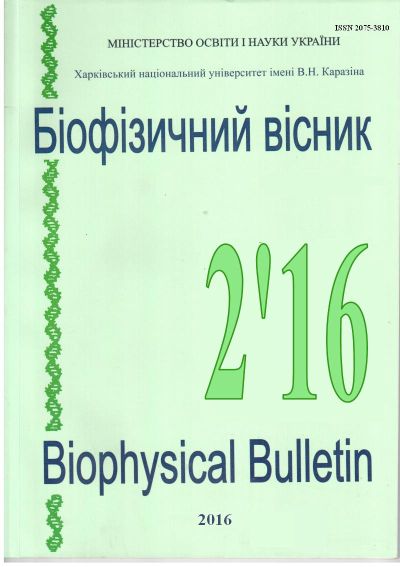Теоретичний аналіз амілоїдогенного потенціалу лізоциму, цитохрому С та аполіпопротеїну А-І
Анотація
З використанням 8 веб-алгоритмів, що включали Pasta2, AmylPred2, Tango, MetAmyl, Waltz, Aggrescan, BetaScan та FoldAmyloid, було проведено теоретичний аналіз амінокислотних послідовностей лізоциму, цитохрому с та N-термінального фрагменту аполіпопротеїну А-І та ідентифіковано їх амілоїдогенні фрагменти. Фрагмент вважався амілоїдогенним, якщо він був ідентифікований щонайменше чотирма алгоритмами. Порівняльний аналіз амілоїдогенних фрагментів нативного та мутантного білків, проведений з використанням різних методів прогнозування, виявив, що усі мутанти характеризуються тими ж амілоїдогенними ділянками, що й нативний білок, однак для мутантних білків агрегаційний потенціал кожної ділянки вище. Показано, що агрегаційні сегменти усіх білків характеризуються збагаченістю гідрофобними аліфатичними (Ile, Val, Leu, Ala) та ароматичними (Trp, Phe, Tyr) амінокислотними залишками. Висловлено припущення щодо ключової ролі гідрофобних взаємодій у процесі агрегації білків.
Завантаження
Посилання
2. Volpatti L, Knowles T. Polymer physics inspired approaches for the study of the mechanical properties of amyloid fibrils. J. Polymer Sci. A. 2014;52:281-92.
3. Adamcik J, Mezzenga R. Protein fibrils from a polymer physics perspective. Macromolecules. 2012;45:1137-50.
4. Tycko R. Solid state NMR studies of amyloid fibril structure. Annu. Rev. Phys. Chem. 2011;62:279-99.
5. Sunde M, Serpell LC, Bartlam M, Fraser PE, Pepys MB, Blake CC. Common core structure of amyloid fibrils by synchrotron X-ray diffraction. J. Mol. Biol. 1997;273:729-39.
6. Wagoner VA, Cheon M, Chang I, Hall CK. Impact of sequence on the molecular assembly of short amyloid peptides. Proteins. 2014;82:1469-83.
7. Garbuzynskiy S, Lobanov M, Galzitskaya O. FoldAmyloid: a method of prediction of amyloidogenic regions from protein sequence. Bioinformatics. 2010;26:326-32.
8. Fernandez-Escamilla AM, Rousseau F, Schymkowitz J, Serrano L. Prediction of sequence-dependent and mutational effects on the aggregation of peptides and proteins. Nat. Biotechnol. 2004;22:1302-6.
9. Maurer-Stroh S, Debulpaep M, Kuemmerer N, Lopez de la Paz M, Martins IC, Reumers J et al. Exploring the sequence determinants of amyloid structure using position-specific scoring matrices. Nat. Methods. 2010;7:237-42.
10. Tsolis AC, Papandreou NC, Iconomidou VA, Hamodrakas SJ. A consensus method for the prediction of “aggregation-prone” peptides in globular proteins. PLoS One. 2013;8:e54175.
11. Emily M, Talvas A, Delamarche C. MetAmyl: a META-predictior of AMYLoid proteins. PLoS One. 2013;8:e79722.
12. Walsh I, Seno F, Tosatto SC, Trovato A. PASTA2: an improved server for protein aggregation prediction. Nucl. Acids Res. 2014;42:W301-7.
13. Bryan AW Jr, Menke M, Cowen LJ, Lindquist SL, Berger B. BETASCAN: probable beta-amyloids identified by pairwise probabilistic analysis. PLoS Comput. Biol. 2009;5:1000333.
14. Conchillo-Solé O, de Groot NS, Avilés FX, Vendrell J, Daura X, Ventura S. AGGRESCAN: a server for the prediction and evaluation of “hot spots” of aggregation in polypeptides. BMC Bioinformatics. 2007;8:65.
15. Frare E, Mossuto MF, Polverino de Laureto P, Dumoulin M, Dobson CM, Fontana A. Identification of the core structure of lysozyme amyloid fibrils by proteolysis. J. Mol. Biol. 2006;361:551-61.
16. Das M, Gursky O. Amyloid-forming properties of human apolipoproteins: sequence analysis and structural insights. Springer Subcellular Biochemistry Series: Lipids in Protein Misfolding 2015;855:175-211.
17. Calamai M, Taddei N, Stefani M, Ramponi G, Chiti F. Relative influence of hydrophobiсity and net charge in the aggregation of two homologous proteins. Biochemistry. 2003;42:15078-83.
18. Tu L, Raleigh D. Role of aromatic interactions in amyloid formation by islet amyloid polypeptide. Biochemistry. 2013;52:333-42.
19. Marek P, Abedini A, Song B, Kanungo M, Johnson ME, Gupta R et al. Aromatic interactions are not required for amyloid fibril formation by islet amyloid polypeptide but do influence the rate of fibril formation and fibril morphology. Biochemistry. 2007;46:3255-61.
20. Gazit E. Self-assembly of short aromatic peptides into amyloid fibrils and related nanostructures. Prion. 2007;1:32-5.
Автори, які публікуються у цьому журналі, погоджуються з наступними умовами:
- Автори залишають за собою право на авторство своєї роботи та передають журналу право першої публікації цієї роботи на умовах ліцензії Creative Commons Attribution License, котра дозволяє іншим особам вільно розповсюджувати опубліковану роботу з обов'язковим посиланням на авторів оригінальної роботи та першу публікацію роботи у цьому журналі.
- Автори мають право укладати самостійні додаткові угоди щодо неексклюзивного розповсюдження роботи у тому вигляді, в якому вона була опублікована цим журналом (наприклад, розміщувати роботу в електронному сховищі установи або публікувати у складі монографії), за умови збереження посилання на першу публікацію роботи у цьому журналі.
- Політика журналу дозволяє і заохочує розміщення авторами в мережі Інтернет (наприклад, у сховищах установ або на особистих веб-сайтах) рукопису роботи, як до подання цього рукопису до редакції, так і під час його редакційного опрацювання, оскільки це сприяє виникненню продуктивної наукової дискусії та позитивно позначається на оперативності та динаміці цитування опублікованої роботи (див. The Effect of Open Access).





